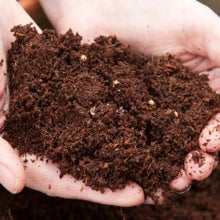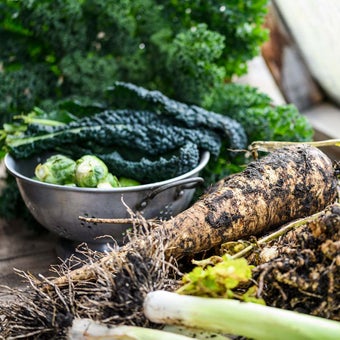
Quick facts
Suitable for - Annual and biennial vegetables
Timing - Sow spring, summer and autumn, depending on the vegetable
Difficulty - Easy to moderate
Suitable for...
Most vegetables are grown from seed each year, except crops such as asparagus, globe artichokes and rhubarb.
When to sow vegetables
Most months of the year, there are vegetables to be sown. The exceptions are December and January when you can plan for the season ahead.
- Sowing can start under cover in February with lettuces and other salad crops and continues until autumn when broad beans are planted for the following summer
- Vegetables such as lettuce, radishes, carrot and chards are often sown in small amounts on a regular basis throughout the to keep supplies constant
How to sow vegetables
The method of sowing depends on which vegetables you want to grow. Some vegetables, carrots and parsnips for example, are sown outdoors, directly in their final positions. Still others, leeks for example, are grown outdoors and later planted to their final positions. Others are sown under cover or indoors for planting out in spring or for and growing under glass. This be can be rewarding if you want to enjoy earlier crops or grow vegetables that need that extra protection.
Direct sowing
It is easiest to sow vegetable seeds in spring, summer and autumn into prepared beds where they will eventually be cropped. This is known as direct sowing.
Station sowing
This is a good way to sow seed economically, since less will be needed after the seeds germinate.
- Sow two or three seeds every few centimetres or where one final plant is intended. The easiest way to do this is by marking out a grid pattern and sowing the seed at the ‘stations’ where the rows cross
- Once the seeds have come up, choose the healthiest and ‘thin out’ the others
Sowing in containers
- Seed trays are suitable for starting off vegetables that will be moved on (known as ‘pricking out’) to their own containers or outside
- Seeds can also be sown in 7.5cm (3in) pots, recycled fruit or vegetable punnets or any other container with drainage holes in the bottom
- or cell trays are a very efficient way of raising , allowing you to transplant, causing minimal damage to delicate roots
- For larger seeds such as broad beans, use deeper, individual containers such as cardboard tubes
- For ‘ ’ crops where the plants will remain, use containers 10-15cm (4-6in) deep
Sowing tender crops in greenhouses and tunnels
- Courgettes, pumpkins, squash, tomatoes, sweetcorn and cucumber are examples of vegetables sown in spring or early summer in a greenhouse or polytunnel for transplanting outside
- Remember to harden off vegetable plants before setting in their positions if they are to go outside
- Crops such as aubergines prefer to be under cover all season, as do glasshouse tomatoes, melons and cucumbers. These can be grown in borders, growbags or containers
- For growing techniques for specific vegetables, please see our Grow Your Own web pages
Sowing crops under cover to extend the season
The can be extended by making use of the warmer, protected environment inside greenhouses and tunnels, and to a lesser extent coldframes, cloches and re-using old .
- Start early and finish late with sowings of chard, coriander, lettuce, parsley and radish
- These can be sown directly into glasshouse borders or into containers without extra heat. Broad beans such as ‘The Sutton’ and ‘Aquadulce Claudia’ can be sown from November to January for cropping in late May-June
Choosing compost
Peat-free seed composts will give more reliable than home-made composts. They will also be low in that are unnecessary for seeds and be free of pests and diseases.
Try to use fresh each year, as it deteriorates if stored. It’s best to use up any old compost along with fresh, in baskets or containers for more mature plants, rather than seedlings.
Sowing vegetables in limited space
Multiblock sowing is an efficient way of using small spaces and involves growing seeds in clusters. This gives a large number of ‘baby’ vegetables and is perfect for beetroot, chives, round carrots, leeks, parsley, spring and bulb onions and turnips.
Many root, bulb or stem vegetables adapt well to this growing technique.
- Fill a module tray with peat-free and water with a watering can and rose attachment and allow to settle
- Sow three to five seeds in a shallow depression in each cell and cover with a thin layer of grit
- Choose a selection of vegetables to avoid over-production of one type
- Do not thin out the
- When the seedlings have their first true leaves, plant out each cell at the correct spacing for that vegetable
Thinning out seedlings
Whether you are sowing in traditional rows or using the station sowing technique, it is important to thin out so that the plants don’t compete with each other for water, and light. See individual vegetable profiles for thinning distances.
- When seedlings have grown their first true leaves (that resemble those of the adult plant, not seed leaves), pinch off the tops of the weakest seedlings at ground level or, better still, remove entire seedlings
- Some crops, such as beetroot, chard and spring onions, can be successively thinned as they mature. The thinnings can be eaten as mini-veg, and those remaining in the ground will then reach full size
- The ideal spacings for each vegetable vary, but will be indicated on the seed packet
Problems
Sometimes will damp off if air circulation is inadequate or conditions are too humid or soggy.
Sometimes sowings will fail to emerge, perhaps due to weather or poor quality seeds. There is usually an opportunity to resow with new seed, and if resowing can be done within two weeks, continuity of cropping won't be much disrupted.
Young seedlings can be vulnerable to:






